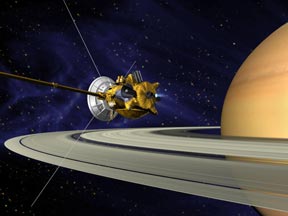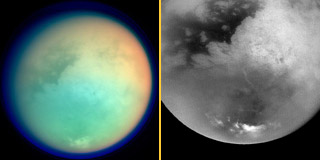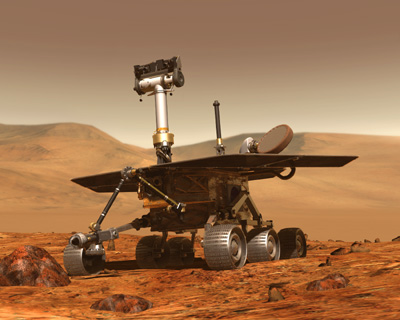Click on image for full size
Image courtesy NASA/JPL.
Cassini arrives at Saturn
News story originally written on June 30, 2004
The Cassini spacecraft will arrive at Saturn on June 30, 2004. Cassini's engine will make a critical 96-minute burn starting at 7:36 p.m. Pacific Time (10:36 p.m. EDT) on June 30. The burn will slow Cassini enough to be captured into orbit around Saturn.
During this Saturn Orbit Insertion (SOI) maneuver, Cassini will pass closer to Saturn than at any other time during its mission. At closest approach Cassini will zip by 19,980 km (12,427 miles) above Saturn's cloud tops. It will also pass through Saturn's rings twice, once before and once after the engine's burn. Cassini will dodge through a gap in the rings (between the F and G rings) in hopes of avoiding collisions with ring particles. It will also turn its main antenna dish forward to act as a shield for the rest of the spacecraft against hypervelocity impacts with dust particles in the rings during its ring passages. Cassini should get great images of the rings during these passes.
Cassini will use its 12 instruments to study Saturn, its rings, and its moons during the spacecraft's scheduled four-year mission in orbit around Saturn. Cassini also carries a smaller probe, named Huygens, which will land on the surface of Saturn's largest moon, Titan, in January 2005. Cassini was launched towards Saturn back in 1997.
We won't know whether Cassini's orbital insertion maneuvers went well until 84 minutes after they happen. That's because Saturn is currently 1.5 billion km (934 million miles), or 84 light minutes, from Earth, and radio signals from the spacecraft travel at the speed of light. The long communication lag means flight controllers cannot make any adjustments to Cassini during the SOI, so any improvisations Cassini must perform (in response to being jostled by a dust particle collision, for instance) during the SOI must be preprogrammed into its computer.














